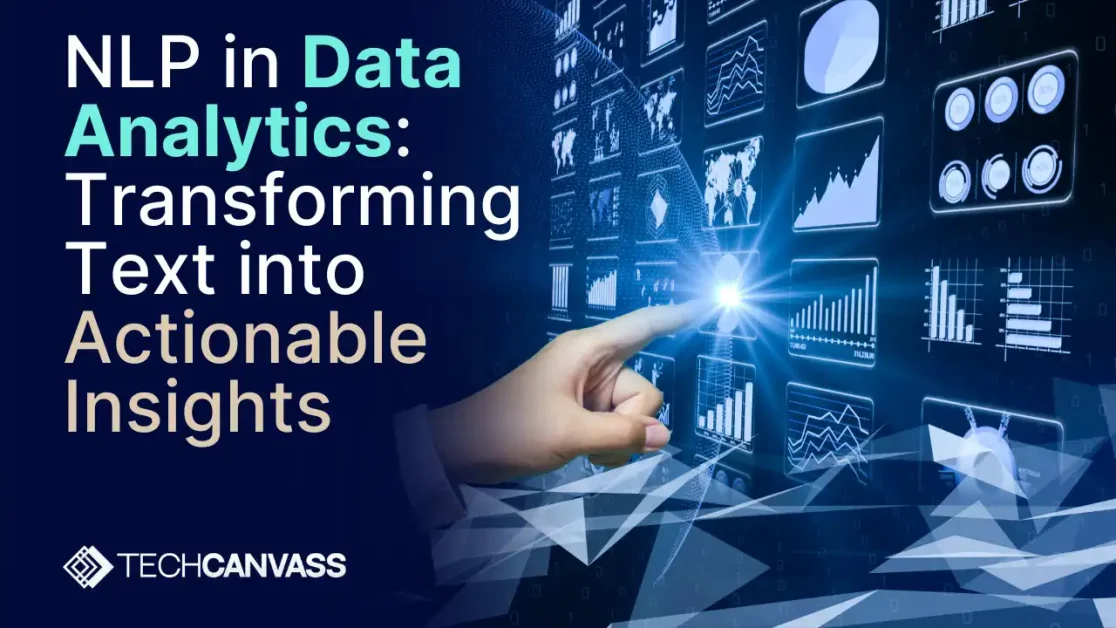Last Updated on September 17, 2025 by Techcanvass Academy
Table of Contents
Overview
We always imagined a world where computers could understand human language as effortlessly as we do. Well now we are living in that world. Computers now can read customer reviews, analyze social media gossips, or summarize lengthy reports in seconds. But how they are able to do it? It’s the power of Natural Language Processing (NLP). In data analytics, NLP serves as a bridge between unstructured text such as emails, tweets, or surveys and actionable insights. NLP in Data Analytics is revolutionizing how businesses make sense of human language. But how does it even work? Do you know? Let’s break it down step by step, keeping the natural human element at the forefront of our discussion.
How does NLP even work?
You’ve probably heard the term “NLP” floating around, but let’s get cozy with what it really means. NLP is a component of artificial intelligence that helps machines understand, analyze, and generate human language. Think of it as educating computers to read between the lines. In the world of data analytics, Natural language Processing turns chaotic, unstructured text into neat, organized data. NLP in Data Analytics provides the tools to structure messy information from multiple sources. Now let’s try to understand how NLP does that by looking at its core components. It is based on the same principles we humans use to process language at a speed of lightening!
To deepen your practical skills, consider enrolling in our AI Certification for Data Analysts, designed to bridge the gap between AI concepts and real-world business applications. You can also explore our detailed guide on who is an AI Data Analyst to understand how this emerging role is shaping the future of data-driven decision-making.
Step 1: Tokenization – Breaking Down the sentences.
- Tokenization divides sentence into smaller parts (words or phrases).
- For example, a customer posts this review: “The product is great, but delivery was slow.” NLP will break it down to Tokens: [“The”, “product”, “is”, “great”, “but”, “delivery”, “was”, “slow”]
- Note this is an important step and without tokenization, a computer sees text as gibberish. These tokens form a foundation for data analysis. NLP in Data Analytics starts its process with tokenization to ensure every word is counted and understood.
Step 2: Stemming– Finding Root Words
- As part of Stemming, words are trimmed to roots. For example, trimming “running” to “run”.
- Next, NLP uses dictionaries to find base forms of the words. For example, “better” is lemmatized as “good”. These words are transformed into numerical vectors allowing computers to understand that “happy” and “pleased” convey similar meanings. NLP in Data Analytics ensures even varied expressions are mapped to similar ideas for better pattern recognition.
Step 3: Tagging Part-of-Speech to the words
- As part of this step words are labeled as nouns, verbs, adjectives, etc. This helps NLP to understand sentence structure:
- “She runs a startup” → “runs” = verb.
- “The runs were successful” → “runs” = here the same word “runs” is tagged as noun. NLP in Data Analytics thrives on this understanding of grammar to deliver accurate insights.
Final step: Named Entity Recognition (NER)
- Here the model tried to identify real-world entities like people, dates, or locations: “Apple launched the iPhone in 2007.” → Apple is identified as Company, iPhone as Product and 2007 as Date. This is how NLP when analyzing customer feedback can automatically extract product names or company mentions. NLP in Data Analytics plays a key role here in identifying specific entities that matter most to a business.
NLP in Data Analytics – The Magic Happens Here
This is the exciting part. Now that text is structured, we will see how do analytics tools use it! I will walk you through a real-world example. The ask for you as data analyst is to Analyze the customer feedback for a newly launched cellphone.
- As a first step in Data Analytics, you need to collect data. You gather data from surveys, emails, social media or ecommerce market place. For instance: “Love the camera! Battery life could be better.” This is how the brands track your hashtags or comments to gauge public sentiment during campaigns.
- Then a typical Data Analyst start performing the analysis using the NLP algorithm I explained above. The NLP will classify the text as positive, negative or neutral. This is also called as Sentiment analysis.
a.“Love the camera!” this will be tagged as a Positive review.
b. “Battery life could be better.” Will be considered as a Negative review.
Here is where you will start spotting trends like battery complaints, camera issues. This will lead you to arrive at a data driven decision to prioritize battery related fixes. NLP in Data Analytics enables such decision-making at scale. - You may further decide to group and cluster similar feedback into themes such as Camera Quality, Battery Issues, etc. NLP in Data Analytics helps to categorize and sort vast feedback pools for easier interpretation.
- A data analyst or a BI specialist will create visualizations using this data. Tools like Power BI and Tableau are used to create dashboards presenting these insights using charts and graphs. Your leadership team or decision makers can now easily see this at a glance: “60% of complaints are related to Battery life”

Challenges of using AI in Data Analytics – It’s not all smooth!
You must admit that language is incredibly complex, filled with ambiguity, sarcasm, and context that machines struggle to interpret accurately. There may be some reviews or comments that may confuse AI. Sometimes AI may not understand the context and ambiguity. Perfect example is this review: “I’m dying to see that movie!” We human can easily comprehend that this has been spoken out of Excitement and is not to be considered as a literal interpretation. Another example is this Idiom: “Piece of cake!”. However, AI may not know this. Similarly see this review which is sarcastic: “Great job breaking the website!” We know this is a negative sentiment, but will AI interpret it that way? Another humorous sarcastic statement such as “just what I needed today” can confuse algorithms that are trained on literal interpretation. NLP in Data Analytics faces these nuanced language barriers and constantly evolves to overcome them.
You as data analyst or for that matter anyone using AI should consider Ethical concerns and other biases while implementing AI in data analytics.
Conclusion
Looking ahead, NLP is set to become even more integral to data analytics. As NLP algorithms become more refined, they will not only analyze data but also generate richer insights that drive business innovation. NLP in Data Analytics will be a central player in the next wave of AI-powered transformation. As AI continues to evolve, we will discover numerous instances where it has demonstrated its presence in Data Analytics. NLP in Data Analytics is not just a trend—it’s the future of how businesses make smarter decisions.
To deepen your practical skills, consider enrolling in our AI Certification for Data Analysts, designed to bridge the gap between AI concepts and real-world business applications. You can also explore our detailed guide on who is an AI Data Analyst to understand how this emerging role is shaping the future of data-driven decision-making.



